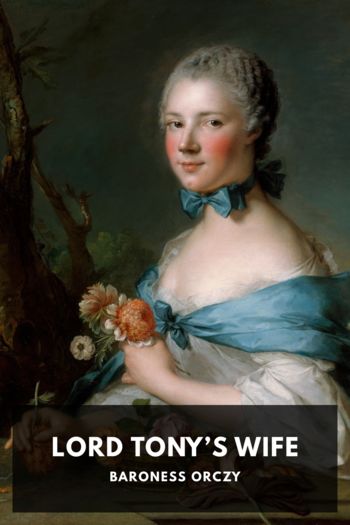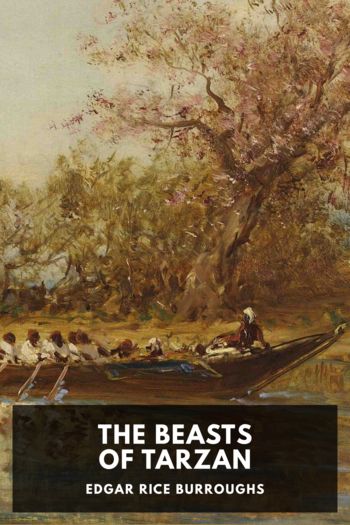Short Fiction, Edgar Allan Poe [best autobiographies to read TXT] 📗

- Author: Edgar Allan Poe
Book online «Short Fiction, Edgar Allan Poe [best autobiographies to read TXT] 📗». Author Edgar Allan Poe
Round the skirts of the valley (which is quite level, and paved throughout with flat tiles), extends a continuous row of sixty little houses. These, having their backs on the hills, must look, of course, to the centre of the plain, which is just sixty yards from the front door of each dwelling. Every house has a small garden before it, with a circular path, a sundial, and twenty-four cabbages. The buildings themselves are so precisely alike, that one can in no manner be distinguished from the other. Owing to the vast antiquity, the style of architecture is somewhat odd, but it is not for that reason the less strikingly picturesque. They are fashioned of hard-burned little bricks, red, with black ends, so that the walls look like a chessboard upon a great scale. The gables are turned to the front, and there are cornices, as big as all the rest of the house, over the eaves and over the main doors. The windows are narrow and deep, with very tiny panes and a great deal of sash. On the roof is a vast quantity of tiles with long curly ears. The woodwork, throughout, is of a dark hue and there is much carving about it, with but a trifling variety of pattern for, time out of mind, the carvers of Vondervotteimittiss have never been able to carve more than two objects—a timepiece and a cabbage. But these they do exceedingly well, and intersperse them, with singular ingenuity, wherever they find room for the chisel.
The dwellings are as much alike inside as out, and the furniture is all upon one plan. The floors are of square tiles, the chairs and tables of black-looking wood with thin crooked legs and puppy feet. The mantelpieces are wide and high, and have not only timepieces and cabbages sculptured over the front, but a real timepiece, which makes a prodigious ticking, on the top in the middle, with a flowerpot containing a cabbage standing on each extremity by way of outrider. Between each cabbage and the timepiece, again, is a little China man having a large stomach with a great round hole in it, through which is seen the dial-plate of a watch.
The fireplaces are large and deep, with fierce crooked-looking firedogs. There is constantly a rousing fire, and a huge pot over it, full of sauerkraut and pork, to which the good woman of the house is always busy in attending. She is a little fat old lady, with blue eyes and a red face, and wears a huge cap like a sugar-loaf, ornamented with purple and yellow ribbons. Her dress is of orange-colored linsey-woolsey, made very full behind and very short in the waist—and indeed very short in other respects, not reaching below the middle of her leg. This is somewhat thick, and so are her ankles, but she has a fine pair of green stockings to cover them. Her shoes—of pink leather—are fastened each with a bunch of yellow ribbons puckered up in the shape of a cabbage. In her left hand she has a little heavy Dutch watch; in her right she wields a ladle for the sauerkraut and pork. By her side there stands a fat tabby cat, with a gilt toy-repeater tied to its tail, which “the boys” have there fastened by way of a quiz.
The boys themselves are, all three of them, in the garden attending the pig. They are each two feet in height. They have three-cornered cocked hats, purple waistcoats reaching down to their thighs, buckskin knee-breeches, red stockings, heavy shoes with big silver buckles, long surtout coats with large buttons of mother-of-pearl. Each, too, has a pipe in his mouth, and a little dumpy watch in his right hand. He takes a puff and a look, and then a look and a puff. The pig—which is corpulent and lazy—is occupied now in picking up the stray leaves that fall from the cabbages, and now in giving a kick behind at the gilt repeater, which the urchins have also tied to his tail in order to make him look as handsome as the cat.
Right at the front door, in a high-backed leather-bottomed armed chair, with crooked legs and puppy feet like the tables, is seated the old man of the house himself. He is an exceedingly puffy little old gentleman, with big circular eyes and a huge double chin. His dress resembles that of the boys—and I need say nothing farther about it. All the difference is, that his pipe is somewhat bigger than theirs and he can make a greater smoke. Like them, he has a watch, but he carries his watch in his pocket. To say the truth, he has something of more importance than a watch to attend to—and what that is, I shall presently explain. He sits with his right leg upon his left knee, wears a grave countenance, and always keeps one of his eyes, at least, resolutely bent upon a certain remarkable object in the centre of the plain.
This object is situated in the steeple of the House of the Town Council. The Town Council are all very little, round, oily, intelligent men, with big saucer eyes and fat double chins, and have their coats much longer and their shoe-buckles much bigger than the ordinary inhabitants of Vondervotteimittiss. Since my sojourn in the borough, they have had several special meetings, and have adopted these three important resolutions:
“That it is wrong to alter the good old course of things:”
“That there is nothing tolerable out of Vondervotteimittiss:” and—
“That we will stick by our clocks and our cabbages.”
Above the session-room of the Council is the steeple, and in the steeple is the belfry, where exists, and has existed time out of mind, the pride and wonder of the village—the great clock of the borough of Vondervotteimittiss. And this is the object to which the





Comments (0)